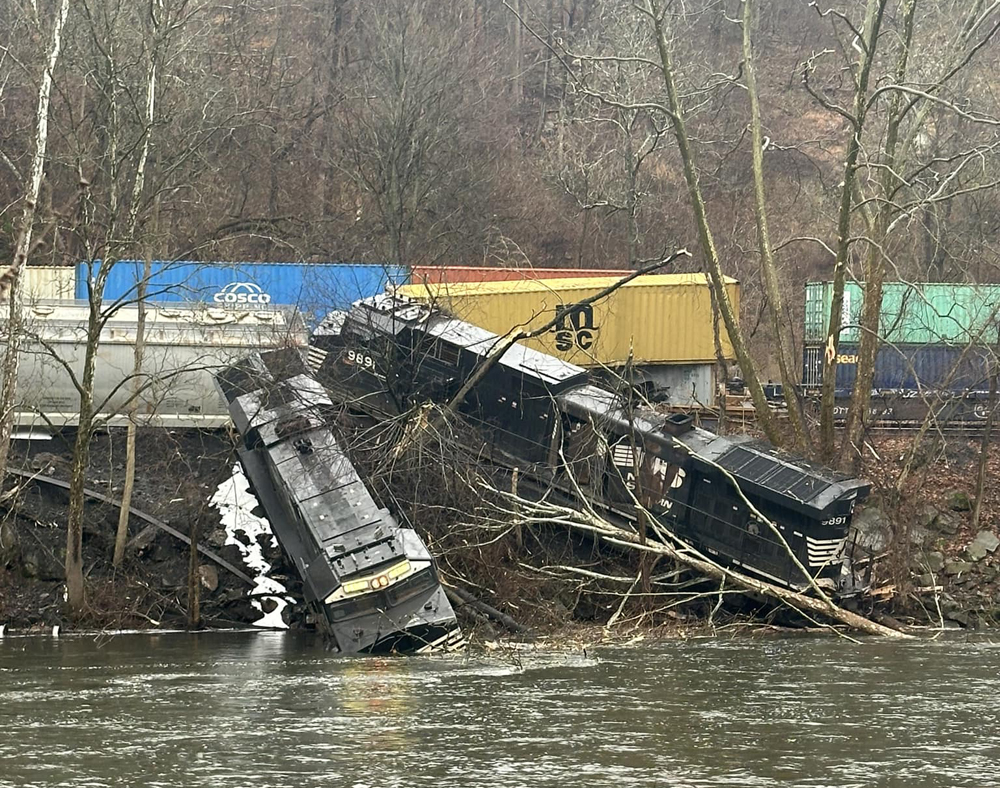
LOWER SAUCON TOWNSHIP, Pa. — A National Transportation Safety Board investigator has filled in town officials on additional details of last weekend’s incident collision and derailment involving three Norfolk Southern trains, saying a total of nine railcars derailed in the incident, WFMZ-TV reports.
Ruben Payan, who is leading the NTSB team looking at train operations, signals, and train control, mechanical systems, and human performance, spoke to the township council at a meeting Wednesday night, March 6, about the incident that sent locomotives, diesel fuel, and plastic pellets into the Lehigh River on Saturday [see “Three-train NS accident in Pennsylvania …,” Trains News Wire, March 2, 2024]. The incident happened quickly, he said: an eastbound train stopped at a signal was rear-ended by an intermodal train, derailing three intermodal cars into an adjacent track; less than a minute later, a westbound train hit those cars, sending the locomotives of that train into the river and derailing six cars.
Previous reports had not offered a count on the number of cars involved.
Three of the six derailed cars from the westbound train were empty but contained ethanol and butane residue, he said, but were not breached and did not leak any fluids. Payan said “minimal” diesel fuel entered the river.
Payan, asked about monitoring systems, said the trains were operating with positive train control, but that at a speed under the system threshold, “the system no longer maintains train separations.” Asked about claims on social media that softening of the roadbed from water runoff was a cause of the incident, Payan said track was not a contributing factor.













All of these answers are are wrong. PTC does not provide protection for the rear of a train in any form other than ensuring the following train does not exceed the 20mph restricted speed threshold. PTC enforces speed restrictions, max track speed, and stop signals. The train was not in restricted mode, it got a restricting signal. I do not know what the crew was doing in the minutes before impact but there is no way with the current technology that PTC could have prevented this. An SOS button to code signals to “stop” is a horrible idea not only because some crews will take advantage of the button, like telling a child not to eat the cake, but it would require them to also become train dispatchers due to FRA requirements.
Nothing is fool proof given a sufficient fool. Restricted speed means restricted speed and it sound like the train following the stopped train did not follow its orders. One thing that should be be done is providing a SOS button which sends out a stop signal to all trains in the vicinity. That sort of thing could have prevented the follow on crash.
Just a second *before* that ‘threshold’ there must have been safe distances between all trains. So there could(should?) have been an automatic, immediate STOP command to the two other trains. Communications should then be transferred to radio for further coordination.
Or is that threshold in need of more examination/tweaking?
The railroad is divided into “blocks.” The following train would have come to an “absolute stop” signal before entering the occupied block of the preceding train. With verbal permission of the dispatcher the following train would have proceeded past the stop signal at restricted speed, usually “no faster than the ability to stop within half the visible distance ahead.” So if rounding a curve you slow WAY down. If it’s a straightaway then you may go a little faster. Why the need to have two trains in the same block? Was the FRED on the first train visible/operating? Did weather play a factor? These and more will be subject to investigation by the Feds.
Given its overall cost of comprehensive installation, I wonder how many collisions have been prevented as a result? Probably there are no data to document the answer to this question.
That’s a great question.
I am m out certainly not a PTC expert. My assumption, however, is that the system is intended to prevent train-separation distance accidents at speeds above a certain threshold. That seems worth maintaining. We don’t want to throw away a system because it can’t do everything. Perhaps a better w\question than “what’s the point” is Can further safeguards be added? Happy to hear from those with more knowledge than I.
The system is supposed to use inputs programmed in such as train length and weight. Then algorithms calculate safe speed for the train AND safe stopping distance for the following train. The system is not refined enough to meet its intended function: each train becomes its own block (floating blocks) and the system keeps the blocks a safe distance from one another whilst using less track space than the legacy block system. The angst for those of us with boots/retired boots on the ground was how Washington insisted this to be “proven technology.” Balderdash.
“[B]ut…at a speed under the system threshold, ‘the system no longer maintains train separations.’” Then what’s the point?
Restricted speed enables a train to continue past a stop or restricting signal. At restricted speed PTC can only enforce speed. PTC is not programmed to know where the rear of the train ahead is located. It may have been that the following train needed to “squeeze” into the block to clear a switch needed by the opposing train. Restricted speed also comes into play when a signal displays stop or restricting when it should not. Could be caused by a broken rail or vandalism.
That’s no different than operations under CTC or any other dispatched railroad. I realize we are all asking too much from PTC but, what was all that money for?